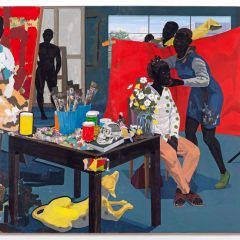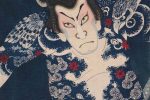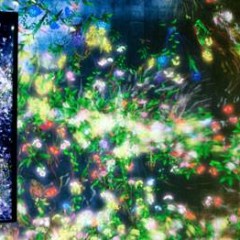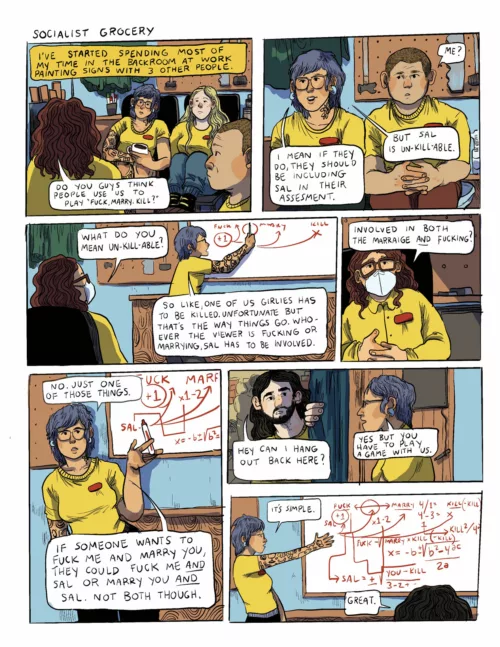This exhibition at the Japan Society through June 13 was a roaring success when shown in London last Spring, and if it’s not drawing equal crowds in New York that’s because the Japan Society is at least four avenues further East than the crowds are willing to gather. It’s New York’s loss. One of the great popular printmakers of 19th-century Japan, he produced the Star Wars of the genre, filled with subjects that make for sure box office hits: swashbuckling battle scenes filled with violence and gore, horror tales with exquisitely-detailed monsters, low comedy and beautiful women. And hits they were: one series of 51 prints sold 8,000 impressions. That’s 480,000 prints!

Kuniyoshi’s work is done with such bravura and visual imagination that it’s not surprising that it inspired many of today’s creators of manga and anime. It has an obvious appeal for artists and illustrators of works that tell stories; he provides lesson after lesson in images filled with excitement, drama, novelty and surprise. Whether showing Samurai battling a huge spider-monster, a skeleton looming over a defiant warrior (above), a Chinese warrior fighting under water, or a figure blowing himself up with a landmine (below), his action and emotion-packed scenes are varied, full of detail and use unexpected points of view. He portrays ghosts as threatening shadows on the sea’s horizon; the intangible bodies of substance-less beings (see the Tengu in the scene with the crocodile-shark, below) are indicated with the key block printed in pale gray and no color; and the complex images of full-body tattoos and boldly-patterned garments wrap around bodies in violent motion.
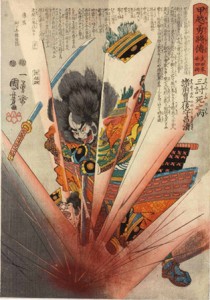
In order to create works of panoramic scope (the size of each image being limited by the size of cherry-wood blocks) Kuniyoshi developed the idea of using three sheets together for a single scene. The exhibition includes a small number of drawings – the likes of which I’ve not seen in years of looking at Japanese print exhibitions. Some are preliminary sketches; two are the finished drawings that would have been given to the block-carvers to paste on the blocks as guides; these survived because the prints were never made.
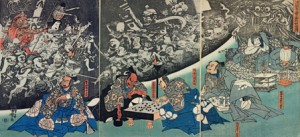
The exhibition demonstrates the imagination with which the artist evaded the government censors who kept a close watch on all printed materials. When forbidden to show brothel scenes he produced detailed images with sparrows dressed in the elaborate kimonos of the women; instead of beautiful courtesans he turned out a series of famous virtuous women. He commented on current politics with parallel scenes from history and myth, ‘riddle pictures’ that were as easily read by his audience as the code words late-night tv comedians use instead of profanity.
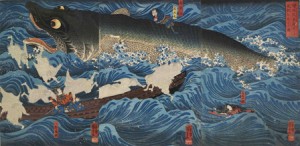
Some of the most delightful images in the exhibition are his comic prints. One depicts graffiti on a wall, with Kuniyoshi’s and his publisher’s signatures as if they were scratched into plaster. Another has fourteen men in loincloths intertwined into a single pattern and, in a send-up of views of the 53 stations of the Tokaido (the road between Kyoto and Edo, most famously depicted by Hiroshige) he shows 53 cats, each of whose name is a pun on the name of each station. The catalog includes a very funny series of comic/erotic prints (more comic than erotic, but not shown in New York) featuring male and female sex organs incorporated into the figures of monsters.
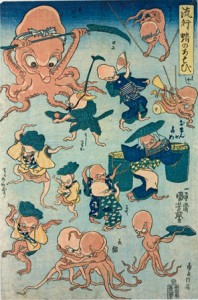
The exhibition also includes prints for fans, several surimono (the expensive prints produced for special collectors, embellished with metallic inks and blind-stamping) and Kuniyoshi’s distinctive landscape prints which were influenced by Western conventions. The work is entirely drawn from the collection of Arthur R. Miller, a New York law professor who has promised the collection to the British Museum. The Japan Society has invited a manga illustrator, Hiroki Otsuka, to be in residence during the exhibition. He’s doing manga workshops and producing work based on Kuniyoshi’s. There is a website which the artist updates as he works.


